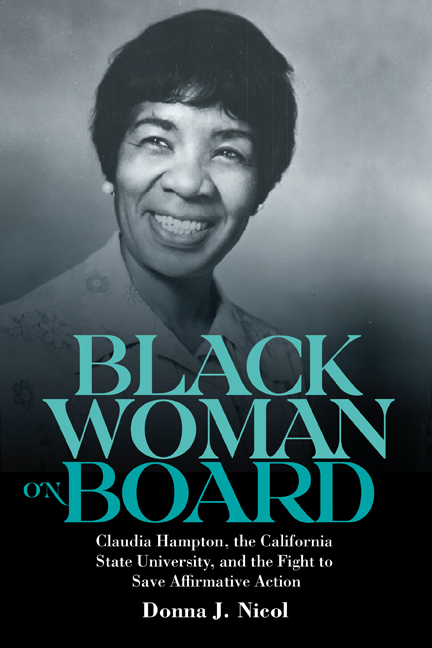 Black Woman on Board
Black Woman on Board Book contents
- Frontmatter
- Dedication
- Contents
- List of Illustrations
- Acknowledgments
- List of Abbreviations
- Introduction: A Very Fortunate Happenstance
- 1 Shifting Notions of the Public Good
- 2 Misgivings about Affirmative Action
- 3 The Conciliator Makes Dinner
- 4 A Hammer in a Velvet Glove
- 5 The Beginning of the End
- Conclusion: The Legacy and The Lessons
- Bibliography
- Appendix: Hampton’s Trustee Committee Service and Leadership
- Index
1 - Shifting Notions of the Public Good
Published online by Cambridge University Press: 09 May 2024
- Frontmatter
- Dedication
- Contents
- List of Illustrations
- Acknowledgments
- List of Abbreviations
- Introduction: A Very Fortunate Happenstance
- 1 Shifting Notions of the Public Good
- 2 Misgivings about Affirmative Action
- 3 The Conciliator Makes Dinner
- 4 A Hammer in a Velvet Glove
- 5 The Beginning of the End
- Conclusion: The Legacy and The Lessons
- Bibliography
- Appendix: Hampton’s Trustee Committee Service and Leadership
- Index
Summary
It would take the threat of a protest during a football game for university officials in the California State College (CSC and later CSU) system to expand their understanding of “education as a public good” to include students of color. This chapter explores how Black student-led protests at CSC campuses across the system forced the CSC Board of Trustees to confront Black and other nonwhite students’ long-ignored claims of racial discrimination and exclusion. These campus protests served as the catalyst for gradual changes within the system, where Claudia Hampton would come to play a key role as a CSC trustee in enforcing affirmative action.
On the evening of September 14, 1967, a headline appeared on the front page of the San Jose News which read “Negro Faculty Member Challenge Claims, San Jose State Race Prejudice Blasted” and in the article, Harry Edwards, a graduate of San Jose State College (SJSC) who had been a star athlete as a student and was now an adjunct sociology professor at the college, was quoted as saying “Segregation is worse here than in Mississippi.” Specifically, Edwards referred to housing discrimination by landlords around the college, who posted vacancies but refused to rent to Black students. Elaborating on the problem of housing discrimination against Black students, Edwards said, “I can show you vacancy signs all over but they’re not vacant for Negroes.”
To San Jose State College President Robert Clark's credit, he quickly mobilized a team under the direction of SJSC executive vice president William Dusel to try to immediately find housing for Black male student-athletes and bring in civil authorities to expose and put pressure on landlords who discriminated against Black students. Shortly following a meeting between Edwards and President Clark, a notice prepared by the United Black Students for Action (UBSA), went out to faculty soliciting their support for the principles for which Black students planned to protest and contained a list of demands that included public deliberations of all problems and solutions related to Black students, increased admission and enrollment of minority students, and public statements from the athletics office, housing, and the office of Greek life, denouncing racism.
- Type
- Chapter
- Information
- Black Woman on BoardClaudia Hampton, the California State University, and the Fight to Save Affirmative Action, pp. 28 - 61Publisher: Boydell & BrewerPrint publication year: 2024


